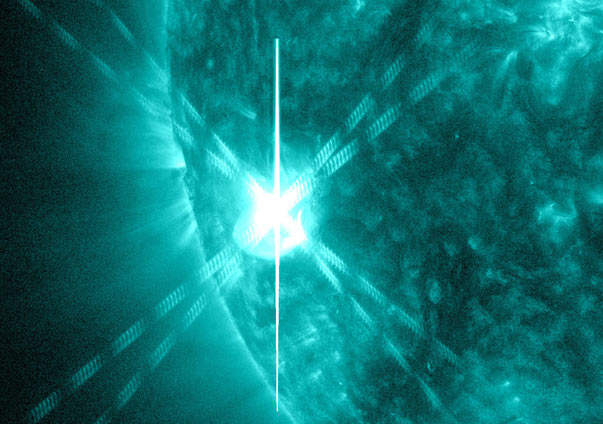Create a free profile to get unlimited access to exclusive videos, sweepstakes, and more!
Oh, snap! Another X-class flare from the Sun

Yesterday, an active region on the sun - basically, a collection of magnetically active sunspots - popped off a series of flares that were actually fairly energetic. NASA's Solar Dynamics Observatory caught the action in this video:
Neat! These shots were in the ultraviolet, where flares are easier to spot.
Sunspots are where the Sun's complex magnetic field pokes through the surface. The field lines store ridiculous amounts of energy (did you see my BAFact for today?), and allow plasma - superheated, ionized gas - to flow along them. Think of these field lines like a pillowcase full of tightly wound springs. If one of them snaps - which can happen if they get too close to each other, for example, or when the churning surface of the Sun ratchets up the tension in the field lines beyond their capacity to restrain themselves - it blasts out its energy, which then snaps other lines, which release their energy, and so on. You get a cascade of explosions, resulting in a solar flare.
Flares can be pretty small, or hugely huge. Scientists categorize them by the amount of X-ray energy released, so we have low-energy C class, medium M class, and yikesingly X class. This flare from yesterday just edged into X class territory, so it was decent, but not too bad. Happily it was on the edge of the Sun, and the blast was directed away from Earth, so it's not expected to affect us. For further reassurance, there have been 14 previous flares since this new sunspot cycle began a couple of years ago, and we're still here.
However, as the Sun spins, this active region is rotating toward us. If it stays active, we could see some interesting events from it that can cause aurorae on Earth. The odds of anything bad happening - power outages, or loss of satellites, for example - are low, but not entirely zero. I personally am not too worried about it, but it's always good to keep our eyes on our nearest star. It can pack quite a punch, and we're still a year or so away from the peak of the current sunspot cycle.
Image credit: NASA/SDO
Related Posts:
- The Sun unleashes an X5.4 class flare
- Awesome X2-class solar flare caught by SDO
- NASAâs guide to solar flares
- The August solar eruption, in HD video!



























